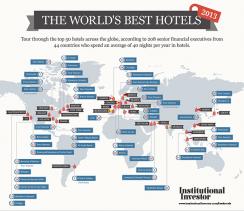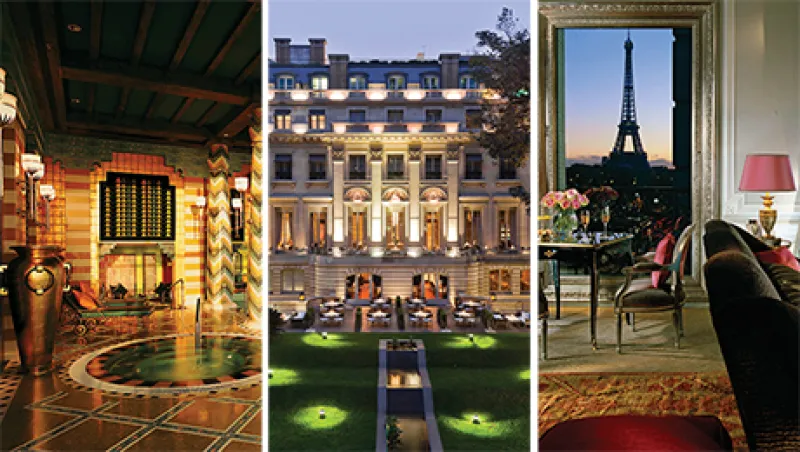Imagine resting your head after a long day of meetings on a 1,000-thread-count cotton pillowcase while watching your favorite movie on a 42-inch LCD TV fitted with a Bose audio system, or just enjoying the view of Japan’s Imperial Palace Gardens with Mount Fuji in the distance. Guests willing to pay top dollar — about $19,590, plus service and tax, per night — can do just that in the 2,896-square-foot Presidential Suite at the Shangri-La Hotel, Tokyo.
Such comforts help the Shangri-La win the top spot in the World’s Best Hotels, Institutional Investor’s annual ranking of the top 100 hotels on the planet. The establishment’s luxurious suites and prime setting are noteworthy, but they are far from unique in an industry that keeps raising the bar.
Ritzy rooms and restaurants used to be enough to lure guests to the world’s leading hotels. Today, however, the überwealthy are demanding unique travel experiences, personalized attention and out-of-this-world accommodations. And they are willing to pay just about anything for them.
Affluent business and leisure travelers are driving the recovery of the hotel industry, says Scott Berman, U.S. hospitality and leisure practice leader at PricewaterhouseCoopers in Miami. Growing demand for high-quality accommodations has driven a rise of 5 to 10 percent in U.S. room rates in the past year, he adds.
“Corporate groups, who left top hotels for dead in 2009, have returned,” Berman says. “Now they like to show off and hold events in luxury properties, many of which are resorts.”
Click image to enlarge

Share This Image on Your Site
To keep up with the superrich Joneses, luxury hotels and resorts have to provide guests with enduring memories, preferably the kind that can easily be shared on social media. Whether guests are traveling for business or pleasure, they are posting pictures and stories for friends, family, colleagues and the general public, says Edwina Kluender, director of communications at the Mandarin Oriental, San Francisco, which ranks No. 11.
“We want to give our guests something to share,” she adds. For example, her hotel has a repeat guest who loves chocolate-chip cookies, so the staff makes sure to have some freshly baked ones ready every time he visits. Another guest once asked for a hair straightener, so there is one in her room whenever she checks in.
At the Shangri-La, which occupies the top 11 floors of the 37-floor Marunouchi Trust Tower, staff walk down to adjacent Tokyo Station to greet guests arriving on Japan’s famous bullet train and escort them to the hotel.
The best of the best have ratcheted up personalized service to include travel experiences authentic to their regions. At the Shangri-La’s CHI spa, guests can enjoy the Yang CHI Energiser, a set of deep-tissue techniques that focus on stimulating points of the body to improve blood circulation, alleviate stress and relieve pain.
In fact, having an extraordinary place to stay is a given for the latest crop of luxury travelers, who want more from their hotels. “We have quite a number of guests where money is not an issue,” says Philippe Frey, general manager of No. 2–ranked Palacio Duhau, Park Hyatt in Buenos Aires. “All that matters are unbelievable experiences from A to Z.”
A multigenerational family staying at the Palacio recently asked staff to organize a dinner. The hotel’s chef interviewed the family and tailored a traditional Argentinean menu for them, serving each course with an explanation of the cooking techniques. A sommelier worked with the chef to pair each course with Argentinean wines. Such a meal costs between $200 and $250 per person at the Palacio.
Any Palacio guest can sign up to take in a polo match, one of the country’s pastimes, and participate in an asado, or Argentinean barbecue, afterward. The hotel offers a similar event featuring tango dancing. During warmer months it puts on “Tango Under the Stars,” which allows guests to watch a dance performance in the garden and sample a specially created menu. Visitors can also view the hotel’s art collection and receive a complimentary tour from a curator.
At the Peninsula New York, which ranks No. 6, guests can arrange to see a Broadway show, meet the cast and tour the stage. They also can tour a New York City Fire Department firehouse, with a chance to hop on a rig.
To compete with newer properties, veterans have had to up their game with renovations and additions. Now that there’s a renaissance of sorts in the luxury sector, companies are willing to invest again, says PwC’s Berman. Both the Mandarin Oriental, San Francisco, and the Peninsula New York recently celebrated their respective 25th anniversaries with makeovers.
The Mandarin Oriental renovated suites, created a new spa and opened a new restaurant, says spokeswoman Kluender. The Asian-inspired spa offers three treatment suites with rain-forest showers, a couple’s suite with twin beds, a dedicated manicure and pedicure area, a relaxation lounge and a fitness center. Age-repair facials and massages that cater to new mothers, travel-weary guests and the downright stressed are among the treatments available.
The new restaurant, Brasserie S&P, follows the foodie trend of focusing on healthy local ingredients. The menu, created by executive chef Adam Mali, features dishes such as grilled local albacore tuna and a Fallon Hills Ranch burger with house-made pickles.
In a similar vein, the Peninsula New York recently opened Clement, a contemporary American restaurant focused on the flavors of the Northeast. The menu by executive chef Brandon Kida offers such local delicacies as Maine lobster, Long Island duck and New Jersey porcelent, or baby pig (with apples, parsnips and cabbage from the Garden State).
The growing demand for luxury accommodation is likely to generate a supply response, says Adam Weissenberg, vice chairman and head of travel, hospitality and leisure at Deloitte Touche Tohmatsu in New York. “You will soon see the construction of high-end, $1,000-per-night hotels with 20, 30, 40 or 50 rooms,” he says.
Luxury chains are looking to increase their footprints, he adds. Once upon a time they considered 50 hotels in major cities to be the most that their clientele would support. Now some could grow to have as many as 300 hotels, including establishments in secondary cities, beyond London, Paris, Hong Kong and New York, Weissenberg says. “Asia is becoming more important to this,” he notes. “That’s where the money is.”
There is one contradiction in the new world of luxury travel: Although guests want to immerse themselves in the culture of the place they are visiting, they still want their hotel to feel like their home away from home.
“Luxury properties are focused on retaining loyal clientele willing to pay more, and the expectations of these guests are evolving,” says PwC’s Berman. “The creature comforts of home are part of the equation.”
Feeling like you’re at home does not mean doing your own laundry or just being comfortable enough to hang around in your sweatpants. At high-end hotels, creating a home away from home means having hotel staff who anticipate your needs and prepare everything before your arrival, writes Mayumi Fujitani, director of communications for Shangri-La, Tokyo, in an e-mail to II.
Ultimately, these hotels can justify their high rates as long as they provide real value by pampering their guests from check-in to checkout. One way to do that is to create a sort of VIP club that gives guests access to the best rooms and additional services and amenities.
At the Shangri-La, Tokyo, for instance, Horizon Club guests stay at one of the establishment’s 41 club rooms and suites. They can head to the Club Lounge for breakfast and for cocktails in the evening. Club membership also includes newspaper and magazine service, in-room check-in and checkout, shoe polishing, garment pressing, a dedicated concierge and a hot beverage of your choice with your wake-up call.
In addition, Horizon Club guests get special attention at the Takashimaya department store, one of the most popular and prestigious stores in Japan. An interpreter, who can translate Japanese into English or Chinese, will join guests on a shopping spree and arrange for all purchases to be sent directly to their rooms. Guests can stop off at the store’s tea salon.
Hiring and training staff who can attend to every detail and create these larger-than-life travel experiences is likely to be a growing challenge. For years, says Deloitte’s Weissenberg, industries like banking have lured talented staff away from luxury properties, which notoriously pay less. This is something the sector will have to deal with as guest demands for the best become ever louder, he adds.
In a world where everyone is connected by the click of a mouse, luxury hotels are providing their clients with top-notch technology. Wi-Fi with great bandwidth is a minimum requirement. Going forward, more hotels will allow guests to download their favorite TV shows for viewing on state-of-the-art televisions and allow them to easily adjust lighting and heating or cooling in their rooms, Weissenberg says.
Touch-screen technology is making an appearance at new Peninsula properties. Beginning this spring the Palacio will offer guests an app for their iPhones or iPads that will serve as a concierge, providing recommendations for restaurants and sights, and city information.
Many luxury properties will go the way of Walt Disney Co. and start tracking their guests’ preferences, says Weissenberg. Walt Disney World guests now sport MagicBands that serve as their room keys, payment methods and passes for park rides. They also track information including a guest’s name, birth date, restaurant seat and activities. After working out the kinks, Disney should be able to use this information to personalize marketing and guests’ travel experiences.
Even without technology, luxury hotels are trying to customize the stays of their guests. “We’re all about consistency,” says the Mandarin Oriental’s Kluender. “We focus on training of staff so that when guests do come and visit, they experience the same perfect day, with new surprises.”
In fact, technology alone won’t be enough to satisfy today’s luxury-craving guests. The personal touch will still be a necessity. Those that will continue to top lists like this one will offer more than a lovely place to rest one’s head.
“More and more, people staying at five-star hotels are looking for authenticity,” says the Palacio’s Frey. “They want to experience the city they’re visiting, both in and out of the hotel. We are not just selling rooms and food anymore.” • •






